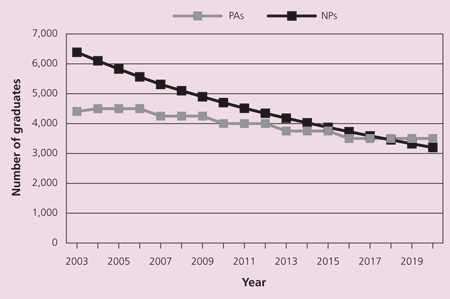
Am Fam Physician. 2005;72(7):1176
The physician assistant (PA) and nurse practitioner (NP) workforces have realized explosive growth, but this rate of growth may be declining. Most PAs work outside primary care; however, the contributions of PAs and NPs to primary care and interdisciplinary teams should not be neglected.
Approximately 50,000 PAs and 115,000 NPs worked in clinical practice in the United States in 2004. PA and NP workforces exploded during the past 15 years and there are now, collectively, more NPs and PAs providing primary care than there are family physicians.1
The PA profession was conceived in 1961 to support and complement physicians, helping them treat more patients, use their time and talents more effectively, and provide better care in the context of a team. The PA profession is explicit in not seeking independent practice. Only 44 percent of PAs currently practice in primary care.2
The NP profession arose in the 1960s in response to the shortage of physicians and opportunities for more advanced practice roles. Limited workforce data make NP practice difficult to assess, but available data suggest that 80 percent of NPs practice in primary care.3 Most NPs work in collaboration with physicians, but efforts to change licensing regulations to allow more independent practice have produced interprofessional clashes.

The annual number of new PA graduates is projected to fall 25 percent by 2020.4 According to the Center for the Health Professions,5 the number of NPs graduating is declining by 4.5 percent every year, but the decline may slow to 3.75 percent by 2020 (see accompanying figure4,5). That most PAs work outside primary care reflects the flexibility of both professions to adjust to market demands. PAs and NPs remain important contributors to the primary care workforce and should not be neglected in workforce projections or in the designing of effective interdisciplinary teams.